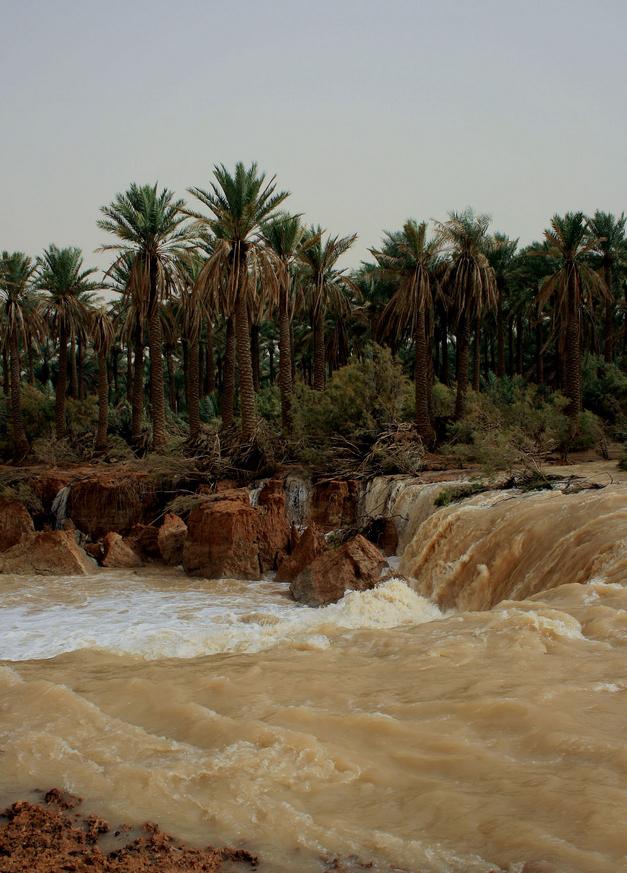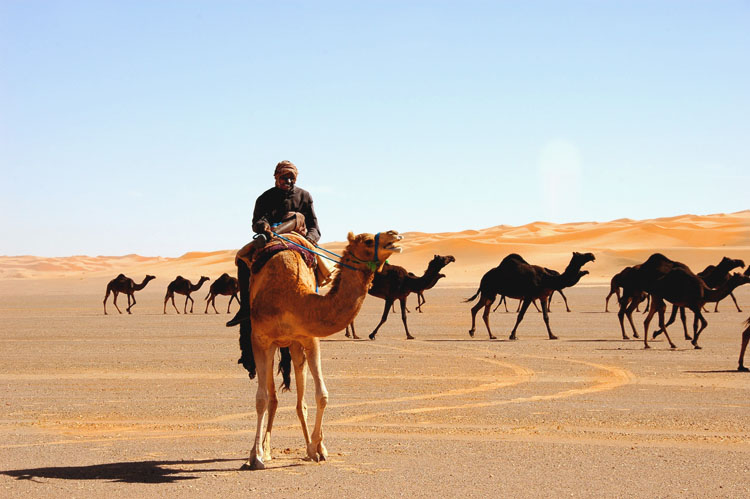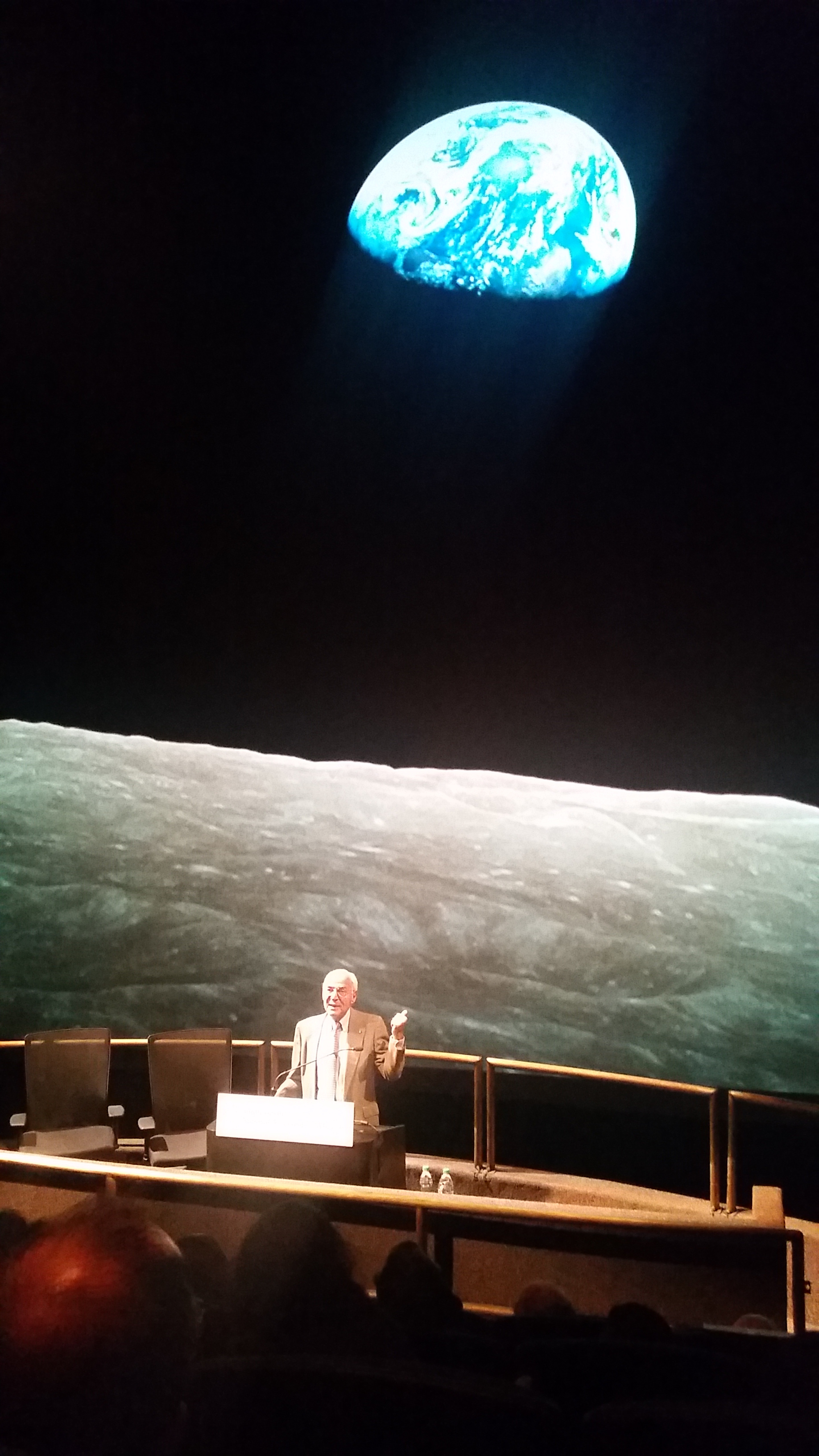|
Wadi Al-Rummah
Wadi Al-Rummah or ar-Rummah (ar: وادي الرمة) is one of the Arabian Peninsula's longest river valleys, at a length of almost . Now mostly dry and partly blocked by encroaching sand dunes, the wadi arises near Medina at Jibāl al Abyaḑ (Al-Abyad Mountain, or The White Mountain). It heads towards the north-east, connecting to several smaller wadis, like Mohalla Wadi and Murghala Wadi to the north and Jifn Wadi and Jarir Wadi to the south. It ends at Thuayrat Dunes of the ad-Dahna Desert in Al-Qassim Province near Buraidah. The wadi then sinks beneath the sand dunes, where it is called Mistewy Wadi. It emerges on the other side of the desert as Wadi Al-Batin (approx. ), which continues towards the north-east and forms the western boundary of Kuwait. It empties finally into the Persian Gulf. The valley is wide, for it was once a major river valley. According to Dr. Abdullah Al-Musnad from the University of Qassim, about 10,000 years ago it was a river flowing from Medina t ... [...More Info...] [...Related Items...] OR: [Wikipedia] [Google] [Baidu] |
Rumah Valley 13 November 2008
Rumah means "house" or "home" in the Indonesian language. It may also refer to: * Rumah Gadang, the traditional house of Minangkabau people, Indonesia * Rumah Lanting This article is about the architecture features of Banjar people of South Kalimantan, Indonesia. There are several types of traditional houses of the Banjarese: #Bubungan Tinggi #Gajah Baliku #Gajah Manyusu #Balai Laki #Balai Bini #Palimbangan ..., the traditional house of Kalimantan, Indonesia * Rumah, Riyadh, a governorate and city in Riyadh Region, Saudi Arabia {{disambiguation ... [...More Info...] [...Related Items...] OR: [Wikipedia] [Google] [Baidu] |
Arabian Peninsula
The Arabian Peninsula, (; ar, شِبْهُ الْجَزِيرَةِ الْعَرَبِيَّة, , "Arabian Peninsula" or , , "Island of the Arabs") or Arabia, is a peninsula of Western Asia, situated northeast of Africa on the Arabian Plate. At , the Arabian Peninsula is the largest peninsula in the world. Geographically, the Arabian Peninsula includes Bahrain, Kuwait, Oman, Qatar, Saudi Arabia, the United Arab Emirates (UAE), and Yemen, as well as the southern portions of Iraq and Jordan. The largest of these is Saudi Arabia. In the classical era, the southern portions of modern-day Syria, Jordan, and the Sinai Peninsula were also considered parts of Arabia (see Arabia Petraea). The Arabian Peninsula formed as a result of the rifting of the Red Sea between 56 and 23 million years ago, and is bordered by the Red Sea to the west and southwest, the Persian Gulf and the Gulf of Oman to the northeast, the Levant and Mesopotamia to the north and the Arabian Sea and the Indian ... [...More Info...] [...Related Items...] OR: [Wikipedia] [Google] [Baidu] |
Valley
A valley is an elongated low area often running between Hill, hills or Mountain, mountains, which will typically contain a river or stream running from one end to the other. Most valleys are formed by erosion of the land surface by rivers or streams over a very long period. Some valleys are formed through erosion by glacier, glacial ice. These glaciers may remain present in valleys in high mountains or polar areas. At lower latitudes and altitudes, these glaciation, glacially formed valleys may have been created or enlarged during ice ages but now are ice-free and occupied by streams or rivers. In desert areas, valleys may be entirely dry or carry a watercourse only rarely. In karst, areas of limestone bedrock, dry valleys may also result from drainage now taking place cave, underground rather than at the surface. Rift valleys arise principally from tectonics, earth movements, rather than erosion. Many different types of valleys are described by geographers, using terms th ... [...More Info...] [...Related Items...] OR: [Wikipedia] [Google] [Baidu] |
Medina
Medina,, ', "the radiant city"; or , ', (), "the city" officially Al Madinah Al Munawwarah (, , Turkish: Medine-i Münevvere) and also commonly simplified as Madīnah or Madinah (, ), is the Holiest sites in Islam, second-holiest city in Islam, and the capital of the Medina Province (Saudi Arabia), Medina Province of Saudi Arabia. , the estimated population of the city is 1,488,782, making it the List of cities and towns in Saudi Arabia, fourth-most populous city in the country. Located at the core of the Medina Province in the western reaches of the country, the city is distributed over , of which constitutes the city's urban area, while the rest is occupied by the Hijaz Mountains, Hejaz Mountains, empty valleys, Agriculture in Saudi Arabia, agricultural spaces and older dormant volcanoes. Medina is generally considered to be the "cradle of Islamic culture and civilization". The city is considered to be the second-holiest of three key cities in Islamic tradition, with Mecca and ... [...More Info...] [...Related Items...] OR: [Wikipedia] [Google] [Baidu] |
Jibāl Al Abyaḑ
Jibāl ( ar, جبال), also al-Jabal ( ar, الجبل), was the name given by the Arabs to a region and province located in western Iran, under the Umayyad and Abbasid Caliphates. Its name means "the Mountains", being the plural of ''jabal'' ("mountain"), highlighting the region's mountainous nature in the Zagros. Between the 12th and 14th centuries, the name Jibal was progressively abandoned, and it came to be mistakenly referred to as ''ʿIrāq ʿAjamī'' ("Persian Iraq") to distinguish it from "Arab Iraq" in Mesopotamia. The region never had any precisely defined boundaries, but was held to be bounded by the Maranjab Desert in the east, by Fars and Khuzistan in the south, by Iraq in the south-west and west, by Adharbayjan in the north-west and by the Alborz Mountains in the north, making it roughly coterminous with the ancient country of Media. Under the Abbasid Caliphate, Jibal formed a separate province, with its capital usually at Rayy, until the Abbasids lost control in ... [...More Info...] [...Related Items...] OR: [Wikipedia] [Google] [Baidu] |
Ad-Dahna Desert
Ad-Dahna Desert is the central division of the Arabian Desert. It is a corridor of sandy terrain forming a bow-like shape that connects an-Nafud desert in the north to Rub' al-Khali desert in the south. Its length is more than siding Twaik Mountains from the east and does not exceed in width. It is also considered the geographical margin separating Al-Ahsa Province from Najd. Al-Dahna Desert is therefore the string that connects the great deserts of Saudi Arabia. The desert is a series of seven successive deserts, separated from one another by plains. Roads pass through Al-Dahnā, linking Kuwait with Al-Zilfī and Riyadh and connecting Riyadh with Hasa. Al-Dahna desert is formed of high sand dunes spreading horizontally which are called veins ( ar, عُرُوْق, ʿUrūq), mostly red in color since it contains Iron Oxides. Caves Beneath the harsh deserts of Saudi Arabia lie dark chambers and complex mazes filled with crystalline structures, stalactites and stalag ... [...More Info...] [...Related Items...] OR: [Wikipedia] [Google] [Baidu] |
Al-Qassim Province
The Qassim Province ( ar, منطقة القصيم ' , Najdi Arabic: ), also known as the Qassim Region, is one of the 13 provinces of Saudi Arabia. Located at the heart of the country near the geographic center of the Arabian Peninsula, it has a population of 1,370,727 and an area of 58,046 km². It is known to be the "alimental basket" of the country, for its agricultural assets. Al-Qassim has the lowest share of population living below local poverty line in Saudi Arabia. It is the seventh most populated region in the country after Jizan and the fifth most densely populated. It has more than 400 cities, towns, villages, and Bedouin settlements, ten of which are recognized as governorates. Its capital city is Buraydah, which is inhabited by approximately 60% of the region's total population. The governor of the province from 1992 to 29 January 2015 was Prince Faisal bin Bandar, succeeded by Prince Faisal bin Mishaal. Etymology Al Qassim also "Al Gassim" "Gassim" deriv ... [...More Info...] [...Related Items...] OR: [Wikipedia] [Google] [Baidu] |
Buraidah
Buraidah ( ar, بريدة ') is the capital and largest city of Al-Qassim Region in north-central Saudi Arabia in the heart of the Arabian Peninsula. Buraydah lies equidistant from the Red Sea to the west and Persian Gulf to the east. Its known for its dates festival which is the biggest in the world with various types of dates. It has been called the city of dates. On November 8, 2021, the United Nations Educational, Scientific and Cultural Organization "UNESCO" included the city of Buraidah within the UNESCO Network of Creative Cities, in the field of gastronomy. Buraydah, the regional capital of Al-Qassim Region, is located on the edge of the Wadi Al-Rummah. Buraydah has a typical desert climate, with hot summers, mild winters and low humidity. In Buraydah, agriculture is still the cornerstone of the economy. The traditional oasis products of dates, lemon, orange and other fruits are still important. Modern introduction of wheat production has become so successful that Buraydah ... [...More Info...] [...Related Items...] OR: [Wikipedia] [Google] [Baidu] |
Kuwait
Kuwait (; ar, الكويت ', or ), officially the State of Kuwait ( ar, دولة الكويت '), is a country in Western Asia. It is situated in the northern edge of Eastern Arabia at the tip of the Persian Gulf, bordering Iraq to the north and Saudi Arabia to the south. Kuwait also shares maritime borders with Iran. Kuwait has a coastal length of approximately . Most of the country's population reside in the urban agglomeration of the capital city Kuwait City. , Kuwait has a population of 4.45 million people of which 1.45 million are Kuwaiti citizens while the remaining 3.00 million are foreign nationals from over 100 countries. Historically, most of present-day Kuwait was part of ancient Mesopotamia. Pre-oil Kuwait was a strategic trade port between Mesopotamia, Persia and India. Oil reserves were discovered in commercial quantities in 1938. In 1946, crude oil was exported for the first time. From 1946 to 1982, the country underwent large-scale modernization, largely b ... [...More Info...] [...Related Items...] OR: [Wikipedia] [Google] [Baidu] |
Persian Gulf
The Persian Gulf ( fa, خلیج فارس, translit=xalij-e fârs, lit=Gulf of Persis, Fars, ), sometimes called the ( ar, اَلْخَلِيْجُ ٱلْعَرَبِيُّ, Al-Khalīj al-ˁArabī), is a Mediterranean sea (oceanography), mediterranean sea in Western Asia. The body of water is an extension of the Indian Ocean located between Iran and the Arabian Peninsula.United Nations Group of Experts on Geographical NameWorking Paper No. 61, 23rd Session, Vienna, 28 March – 4 April 2006. accessed October 9, 2010 It is connected to the Gulf of Oman in the east by the Strait of Hormuz. The Shatt al-Arab river delta forms the northwest shoreline. The Persian Gulf has many fishing grounds, extensive reefs (mostly rocky, but also Coral reef, coral), and abundant pearl oysters, however its ecology has been damaged by industrialization and oil spills. The Persian Gulf is in the Persian Gulf Basin, which is of Cenozoic origin and related to the subduction of the Arabian Plate u ... [...More Info...] [...Related Items...] OR: [Wikipedia] [Google] [Baidu] |
Farouk El-Baz
Farouk El-Baz ( arz, فاروق الباز, ''Pronunciation'': ) (born January 2, 1938) is an Egyptian American space scientist and geologist, who worked with NASA in the scientific exploration of the Moon and the planning of the Apollo program. He was a leading geologist on the program, responsible for studying the geology of the Moon, the selection of landing sites for the Apollo missions, and the training of astronauts in lunar observations and photography. He played a key role in the Apollo 11 Moon landing mission, and later Apollo missions. He also came up with the idea of touchable Moon rocks at a museum, inspired by his childhood pilgrimage to Mecca where he touched the Black Stone (which in Islam is believed to be sent down from the heavens). He is married, has four daughters, and has six grandchildren. He was a Senior Advisor to Egypt's former president Hosni Mubarak. Currently, El-Baz is a Research Professor and Director of the Center for Remote Sensing at Boston Univ ... [...More Info...] [...Related Items...] OR: [Wikipedia] [Google] [Baidu] |

.png)






